Shiseido Synchro Skin Radiant Lifting Foundation SPF 30 Versus Neutrogena Hydro Boost Hydrating Tint for Dry Skin
What's inside
What's inside
 Key Ingredients
Key Ingredients

 Benefits
Benefits

 Concerns
Concerns

 Ingredients Side-by-side
Ingredients Side-by-side

Ethylhexyl Methoxycinnamate 6.9%
UV AbsorberTitanium Dioxide 1%
Cosmetic ColorantWater
Skin ConditioningDimethicone
EmollientDiphenylsiloxy Phenyl Trimethicone
Skin ConditioningGlycerin
HumectantTrifluoropropyldimethyl/Trimethylsiloxysilicate
EmollientButylene Glycol
HumectantHydrogenated Polydecene
EmollientPEG-10 Dimethicone
Skin ConditioningBis-Butyldimethicone Polyglyceryl-3
CleansingDisteardimonium Hectorite
StabilisingErythritol
HumectantXylitol
HumectantSorbitan Sesquiisostearate
EmulsifyingPolyquaternium-51
Skin ConditioningCitrus Unshiu Peel Extract
MaskingThymus Serpyllum Extract
Skin ConditioningFagus Sylvatica Bud Extract
TonicHydrolyzed Conchiolin Protein
Skin ConditioningDimethicone/Vinyl Dimethicone Crosspolymer
Skin ConditioningDimethicone/PEG-10/15 Crosspolymer
CI 77120
Cosmetic ColorantSynthetic Fluorphlogopite
Aluminum Hydroxide
EmollientPolysilicone-2
Disodium EDTA
Stearic Acid
CleansingCalcium Aluminum Borosilicate
Tocopherol
AntioxidantDipropylene Glycol
HumectantTriethoxycaprylylsilane
Triethoxysilylethyl Polydimethylsiloxyethyl Dimethicone
Skin ConditioningBHT
AntioxidantAlumina
AbrasivePolymethylsilsesquioxane
Phenoxyethanol
PreservativeIron Oxides
Mica
Cosmetic ColorantEthylhexyl Methoxycinnamate 6.9%, Titanium Dioxide 1%, Water, Dimethicone, Diphenylsiloxy Phenyl Trimethicone, Glycerin, Trifluoropropyldimethyl/Trimethylsiloxysilicate, Butylene Glycol, Hydrogenated Polydecene, PEG-10 Dimethicone, Bis-Butyldimethicone Polyglyceryl-3, Disteardimonium Hectorite, Erythritol, Xylitol, Sorbitan Sesquiisostearate, Polyquaternium-51, Citrus Unshiu Peel Extract, Thymus Serpyllum Extract, Fagus Sylvatica Bud Extract, Hydrolyzed Conchiolin Protein, Dimethicone/Vinyl Dimethicone Crosspolymer, Dimethicone/PEG-10/15 Crosspolymer, CI 77120, Synthetic Fluorphlogopite, Aluminum Hydroxide, Polysilicone-2, Disodium EDTA, Stearic Acid, Calcium Aluminum Borosilicate, Tocopherol, Dipropylene Glycol, Triethoxycaprylylsilane, Triethoxysilylethyl Polydimethylsiloxyethyl Dimethicone, BHT, Alumina, Polymethylsilsesquioxane, Phenoxyethanol, Iron Oxides, Mica
Water
Skin ConditioningCyclopentasiloxane
EmollientDimethicone
EmollientDiphenylsiloxy Phenyl Trimethicone
Skin ConditioningButylene Glycol
HumectantGlycerin
HumectantDimethicone/PEG-10/15 Crosspolymer
Mica
Cosmetic ColorantPEG-9 Polydimethylsiloxyethyl Dimethicone
EmulsifyingDimethicone/Vinyl Dimethicone Crosspolymer
Skin ConditioningAcrylates/Dimethicone Copolymer
Skin ConditioningPhenoxyethanol
PreservativeMagnesium Sulfate
Hydroxyethylcellulose
Emulsion StabilisingDisodium EDTA
Chlorphenesin
AntimicrobialSodium Hyaluronate
HumectantAluminum Dimyristate
Emulsion StabilisingTriethoxycaprylylsilane
Disodium Stearoyl Glutamate
CleansingTitanium Dioxide
Cosmetic ColorantIron Oxides
Water, Cyclopentasiloxane, Dimethicone, Diphenylsiloxy Phenyl Trimethicone, Butylene Glycol, Glycerin, Dimethicone/PEG-10/15 Crosspolymer, Mica, PEG-9 Polydimethylsiloxyethyl Dimethicone, Dimethicone/Vinyl Dimethicone Crosspolymer, Acrylates/Dimethicone Copolymer, Phenoxyethanol, Magnesium Sulfate, Hydroxyethylcellulose, Disodium EDTA, Chlorphenesin, Sodium Hyaluronate, Aluminum Dimyristate, Triethoxycaprylylsilane, Disodium Stearoyl Glutamate, Titanium Dioxide, Iron Oxides
 Reviews
Reviews

Ingredients Explained
These ingredients are found in both products.
Ingredients higher up in an ingredient list are typically present in a larger amount.
Butylene Glycol (or BG) is used within cosmetic products for a few different reasons:
Overall, Butylene Glycol is a safe and well-rounded ingredient that works well with other ingredients.
Though this ingredient works well with most skin types, some people with sensitive skin may experience a reaction such as allergic rashes, closed comedones, or itchiness.
Learn more about Butylene GlycolDimethicone is a type of synthetic silicone created from natural materials such as quartz.
What it does:
Dimethicone comes in different viscosities:
Depending on the viscosity, dimethicone has different properties.
Ingredients lists don't always show which type is used, so we recommend reaching out to the brand if you have questions about the viscosity.
This ingredient is unlikely to cause irritation because it does not get absorbed into skin. However, people with silicone allergies should be careful about using this ingredient.
Note: Dimethicone may contribute to pilling. This is because it is not oil or water soluble, so pilling may occur when layered with products. When mixed with heavy oils in a formula, the outcome is also quite greasy.
Learn more about DimethiconeDimethicone/PEG-10/15 Crosspolymer is a type of silicone.
This ingredient is a silicone used to improve the texture of products and absorb oil. It does not get absorbed into the skin.
Like other silicones, Dimethicone/Vinyl Dimethicone Crosspolymer helps condition the skin by creating a barrier. In this sense, it can act as an emollient and trap moisture in.
This ingredient is a type of elastomer.
Learn more about Dimethicone/Vinyl Dimethicone CrosspolymerDiphenylsiloxy Phenyl Trimethicone is a silicone. It has a high refractive index and adds shine to formulations.
According to the safety review by the Cosmetic Ingredient Review (CIR) Expert Panel, it is safe for use in cosmetics under the current practices and concentrations.
Disodium EDTA plays a role in making products more stable by aiding other preservatives.
It is a chelating agent, meaning it neutralizes metal ions that may be found in a product.
Disodium EDTA is a salt of edetic acid and is found to be safe in cosmetic ingredients.
Learn more about Disodium EDTAGlycerin is already naturally found in your skin. It helps moisturize and protect your skin.
A study from 2016 found glycerin to be more effective as a humectant than AHAs and hyaluronic acid.
As a humectant, it helps the skin stay hydrated by pulling moisture to your skin. The low molecular weight of glycerin allows it to pull moisture into the deeper layers of your skin.
Hydrated skin improves your skin barrier; Your skin barrier helps protect against irritants and bacteria.
Glycerin has also been found to have antimicrobial and antiviral properties. Due to these properties, glycerin is often used in wound and burn treatments.
In cosmetics, glycerin is usually derived from plants such as soybean or palm. However, it can also be sourced from animals, such as tallow or animal fat.
This ingredient is organic, colorless, odorless, and non-toxic.
Glycerin is the name for this ingredient in American English. British English uses Glycerol/Glycerine.
Learn more about GlycerinMica is a naturally occurring mineral used to add shimmer and color in cosmetics. It can also help improve the texture of a product or give it an opaque, white/silver color.
Serecite is the name for very fine but ragged grains of mica.
This ingredient is often coated with metal oxides like titanium dioxide. Trace amounts of heavy metals may be found in mica, but these metals are not harmful in our personal products.
Mica has been used since prehistoric times throughout the world. Ancient Egyptian, Indian, Greek, Roman, Aztec, and Chinese civilizations have used mica.
Learn more about MicaPhenoxyethanol is a preservative that has germicide, antimicrobial, and aromatic properties. Studies show that phenoxyethanol can prevent microbial growth. By itself, it has a scent that is similar to that of a rose.
It's often used in formulations along with Caprylyl Glycol to preserve the shelf life of products.
Titanium dioxide is a mineral UV filter widely used in sunscreens and cosmetics.
It is one of only two UV filters officially classified as “mineral” by regulatory agencies, the other being zinc oxide.
Titanium dioxide provides broad-spectrum protection mostly in the UVB and UVAII range, with some protection in the UVAI range.
While its UVA protection isn’t as strong as zinc oxide’s, the difference is minor.
A common myth is that mineral UV filters reflect UV light. However, modern research shows titanium dioxide absorbs UV radiation like chemical filters (~95% absorption & 5% reflection).
Thanks to its non-irritating nature, titanium dioxide is suitable for sensitive, acne-prone, or redness-prone skin. It is unlikely to cause "eye sting" like other sunscreen ingredients.
A major drawback of this ingredient is its white cast and thick texture. This is why mineral sunscreens often leave a white cast and are less cosmetically elegant than chemical/hybrid sunscreens.
To improve white cast and spreadability, micronized or nano-sized titanium dioxide is often used.
There are ongoing concerns surrounding nano-titanium oxide's impact on marine ecosystems.
There is no conclusive evidence that any form of titanium oxide (or any other sunscreen ingredients) will cause harm to marine ecosystems or coral reefs. The science is still developing but many consumers are keeping a close eye on this issue.
Please note, many destinations have reef-safety sunscreen rules. For instance, the U.S. Virgin Islands advises all visitors to use non-nano mineral sunscreens.
Nano mineral sunscreens once raised safety concerns about absorption into skin.
Extensive research has shown that they do not penetrate healthy or damaged skin; they remain safely on the surface and the top layer of dead skin (stratum corneum).
You'll likely find titanium dioxide bundled with alumina, silica, or dimethicone. These ingredients help make titanium dioxide highly photostable; this prevents it from interacting with other formula components under UV light.
Learn more about Titanium DioxideTriethoxycaprylylsilane is a silicone used to bind and stabilize ingredients.
As an emulsifier, it helps prevent ingredients from separating. This can help elongate the shelf life of products.
Triethoxycaprylylsilane is often used to coat mineral sunscreens ingredients to help give a better feel. It also helps reduce oxidative stress in sunscreens.
Learn more about TriethoxycaprylylsilaneWater. It's the most common cosmetic ingredient of all. You'll usually see it at the top of ingredient lists, meaning that it makes up the largest part of the product.
So why is it so popular? Water most often acts as a solvent - this means that it helps dissolve other ingredients into the formulation.
You'll also recognize water as that liquid we all need to stay alive. If you see this, drink a glass of water. Stay hydrated!
Learn more about WaterThis ingredient is a combination of red, black, and yellow iron oxide pigments. This combination of colors is usually found in foundation, because it results in a "skin" color.